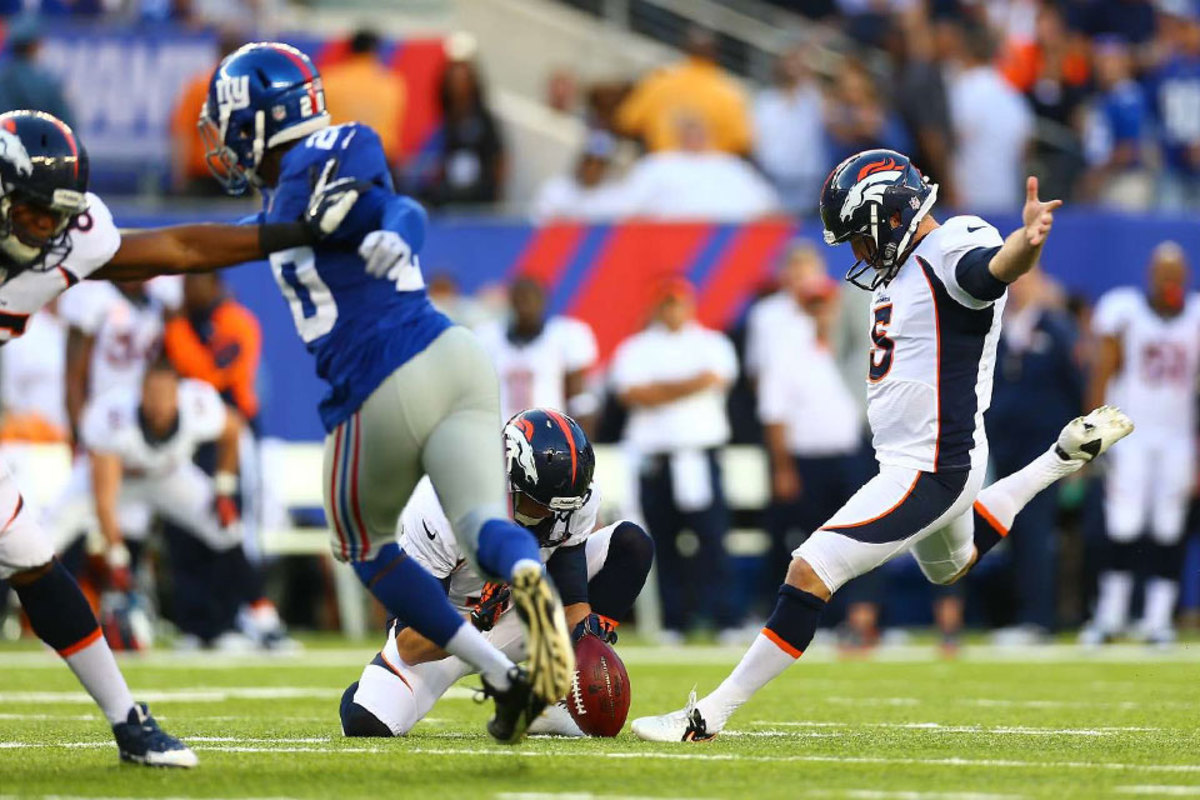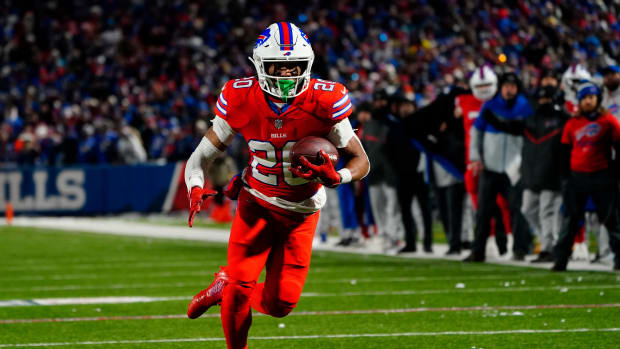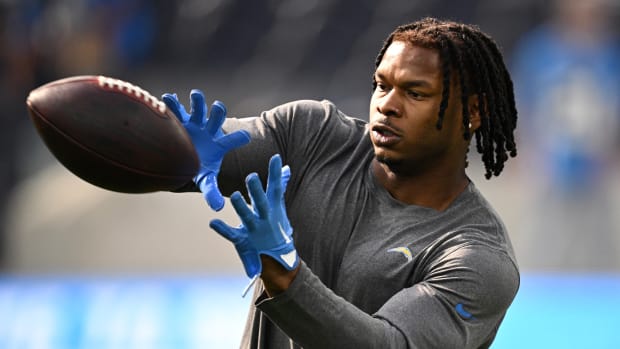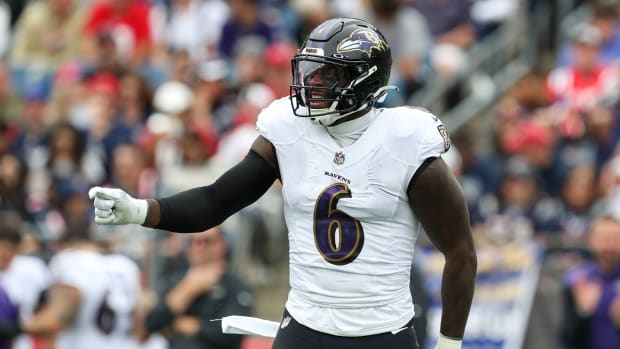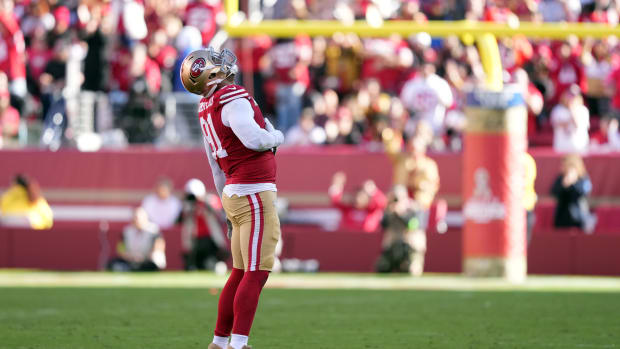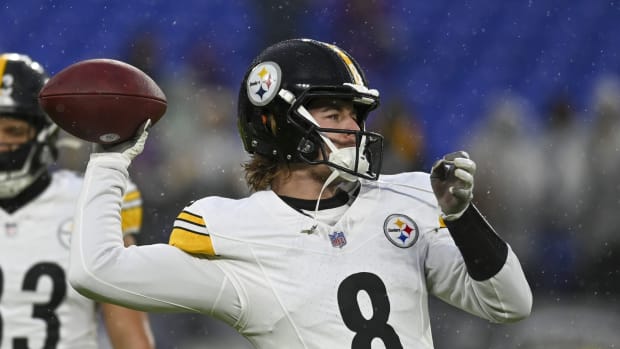The Tricks of Kicking at MetLife, from the Men Who Know
NEW YORK CITY — Besides all the dressings that will adorn MetLife Stadium on Super Bowl Sunday, another was once considered: flaps. The idea of adding something along the lines of oversized window shutters to the exterior of the stadium, to shield the inside from the elements, was broached during an early planning meeting between the NFL and the Super Bowl XLVIII host committee. But ultimately, an NFL spokesman recalls, the verdict was they were “not necessary.” The league will take its chances with the cold, and with the notorious Meadowlands winds.
This isn’t the old Giants Stadium, where the swirling winds were second in legend only to Jimmy Hoffa’s remains—but it’s also not the doldrums. On any given football Sunday, there’s a palpable breeze across your face down on the field, which feels like it’s coming through slot-like openings in the first concourse underneath the four corner video boards.
How could these currents affect Super Bowl Sunday? We asked three experts—Giants punter Steve Weatherford, Jets kicker Nick Folk and former Jets special teams coordinator Mike Westhoff—for a guide to MetLife Stadium’s winds. The one other player with as much experience with those elements is Giants quarterback Eli Manning, and he made perfectly clear on a conference call last week that he’ll save his tips for big brother Peyton.
THE WIND PATTERNS
The Tricks of Kicking at MetLife, from the Men Who Know
The MetLife cross-breeze can nudge the ball sideways during a punter’s drop. (Carlos M. Saavedra/SI/The MMQB)
Winds were 7mph when the Seahawks visited the Giants in December. (Carlos M. Saavedra/SI/The MMQB)
The elements didn’t bother John Ryan. (Carlos M. Saavedra/SI/The MMQB)
He had a 41.3-yard average and a 37.9-yard net on seven punts. (Carlos M. Saavedra/SI/The MMQB)
There’s a typical pattern to the wind inside MetLife Stadium that Folk and Weatherford have noticed through 32 regular-season home games each: The wind blows in from each end zone to about the 30-yard line, and then between the 30-yard lines it blows horizontally across the field from the home (east) to visitor (west) sideline.
What does this mean? “It almost always feels like you’re kicking a field goal into a breeze,” explains Folk, who only missed one field goal at home in 2013, from 49 yards. Ditto for throwing a pass into the endzone. On kickoffs, the current coming out from the endzone can make it more difficult to hit a touchback.
The pattern works better for punters, who are aided by a wind at their back when punting from deep within their own territory. For both directional punts and kickoffs, if there is enough of a wind to matter, the cross-current in the middle of the field determines the direction of the kick. Weatherford says about 70 percent of his punts at MetLife Stadium were hit toward the visiting sideline.
But just because there’s a pattern doesn’t mean the wind always follows it. “Just when you think you’ve got it figured out,” Weatherford says, “you go into a game like we had against the Raiders: 25 mile-per-hour winds, and it’s gusting, and it’s swirling, and it’s blustery. It was just miserable.”
During that game, in early November, Weatherford averaged just 30.3 yards per punt—more than 16 yards below his season average. The conditions that day, he and Giants coach Tom Coughlin agreed, were reminiscent of the old Giants Stadium.
HOW TO PLAY IT
Even big-legged kickers like Matt Prater—who booted a record 64-yarder against Tennessee this season—can find the Meadowlands a daunting environment. (Dustin Bradford/Getty Images)
Pre-game warm-ups are for more than just warming up—they’re the chance players have to test the conditions. At places like MetLife Stadium, charting the winds is critical.
Weatherford uses a small piece of pre-wrap (the thin, silky wrap players use underneath athletic tape) as a mini-flag, wrapping it around his finger with about three inches hanging off. About an hour-and-a-half before kickoff, he walks from the back of the end zone to the 50-yard line on each end of the field, stopping every five yards to see which way the flag blows. After he changes into his uniform, he’ll hit about 35 punts, testing almost every scenario in the game.
Folk walks from end zone to end zone down the hash marks twice—once when he arrives at the stadium and once when he comes out to stretch—looking to pick up clues before he begins his pre-game kicking routine. He’ll try about eight or nine field goals on each side of the field to lock down a range specific to that day, because that range can very greatly.
For example: The Jets played two games at MetLife two weeks apart in December. The first, versus Oakland on Dec. 8, was a 33-degree day with some wind that kicked up, and Folk’s maximum range—for an end-of-the half, nothing-to-lose kick—was between 52 and 55 yards. Against Cleveland on Dec. 22, a 70-degree day with almost no wind, he made a 62-yarder in pre-game. “That’s a big difference for 14 days in December,” says Folk.
Is there a range in which wind doesn’t matter? Folk says on field-goal tries of 30 yards or less or extra points, it’s not an issue to pound the kick through the wind. Punters work differently, because they’re hitting a moving target that can be pushed by the wind during tenths of the second of the drop.
Tall punters—like the 6-2 Weatherford and Denver’s 6-3 Britton Colquitt—usually reap the benefits of their long legs creating powerful swings. But Weatherford says this can actually be a disadvantage in windy conditions, because the longer drop means the wind has more time to move the ball. In gusty conditions he’ll try to hang onto the ball as long as he can to reduce the length of the drop, trading some power in order to make solid contact with the football.
Weatherford also abides by this rule of thumb: When it’s breezy, swing easy. He likens punting in the wind to hitting a golf ball off a moving tee; the goal is to make good contact, rather than trying to crush the ball and risking a mis-hit.
SUPER BOWL SUNDAY
The winds generally blow in from both endzones, which could make touchbacks tough for Steven Hauschka and his Denver counterpart. (Carlos M. Saavedra/SI/The MMQB)
Here’s something the Broncos and Seahawks can hope for on Super Bowl Sunday: The winds at MetLife Stadium have a history of dying down late in the day.
“At 6 p.m. you’re not going to have a wind,” Westhoff says confidently, referring to the 6:30 p.m. kickoff of Super Bowl XLVIII, “unless there’s a front coming in.”
Super Bowl 48
The MMQB’s complete coverage of Super Bowl XLVIII.
Folk and Weatherford agree, pinpointing the windiest time at their home stadium as between 1 and 3 p.m.—in normal weather conditions. Wind, of course, is just one of the factors that affects the flight of the ball; temperature is another. Kicks and punts (and passes) don’t travel as far in colder temperature. Colder air is denser so there’s more drag, and a cold football is also less elastic, which means it doesn’t spring off the foot as easily as a warmer football.
It’s too soon to know for certain what either the temperature or the wind will be like at game time (the forecast as of Tuesday was for temperatures in the 30s and winds of around 9 mph, but because this is the Super Bowl and because there’s a two-week layoff beforehand, teams sift through scenarios and grasp for clues.
Weatherford ranks MetLife Stadium with Cleveland’s FirstEnergy Stadium as the third toughest place in the league to kick, behind only Chicago and Buffalo. Westhoff is an easier grader; he points out, for example, that in New England’s Gillette Stadium, which is not an enclosed bowl, the wind comes through the wide and open main entrance “like a freight train.”
* * *
Britton Colquitt averaged 42.0 yards on five punts at MetLife in September. Winds were a scant 3 mph. (Richard Brightly/Icon SMI)
There’s already been a memorable example this postseason of how the kicking parameters at a stadium affected a game’s outcome. Before the Seahawks’ pivotal fourth-and-7 conversion in the NFC Championship Game, the coaches called for a field goal. But Seattle kicker Steven Hauschka waved them off: The Seahawks were on San Francisco’s 35-yard-line, and for a kick that direction and what he assessed as “into the wind a little bit,” the limit to his range was the 32-yard line.
“I don’t want to kick it,’ ” Hauschka told his coaches.
Seattle went for it instead, scored on a 35-yard touchdown pass from Russell Wilson to Jermaine Kearse, and punched a ticket to Super Bowl XLVIII.
That’s the advantage of playing at home—one neither the Broncos nor the Seahawks will have this Sunday. Weatherford, who has been playing at MetLife Stadium since it opened in 2010, said it’s taken him two-and-a-half to three years to really understand the wind patterns.
Both Super Bowl teams played at the venue during the regular season, though, and as the saying goes, the conditions will be the same for both sides. And like the host committee, the hometown kickers are rooting for mild.
“I really hope they get a good day,” Folk says, “so the Super Bowl will come back to New York one day.”
































